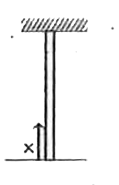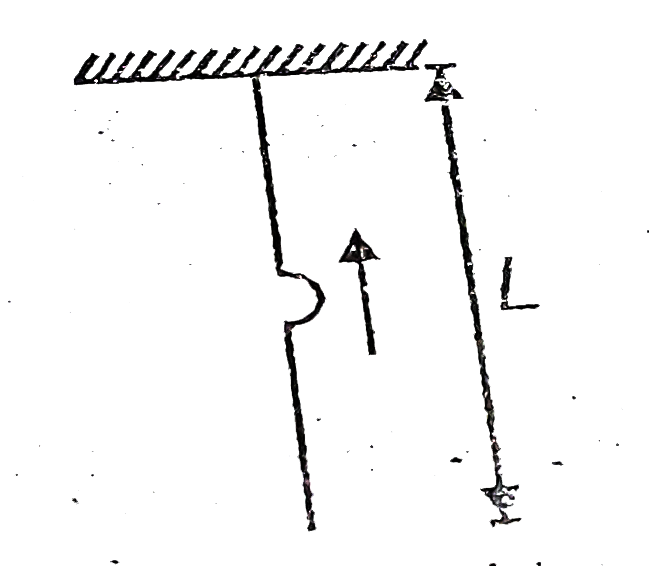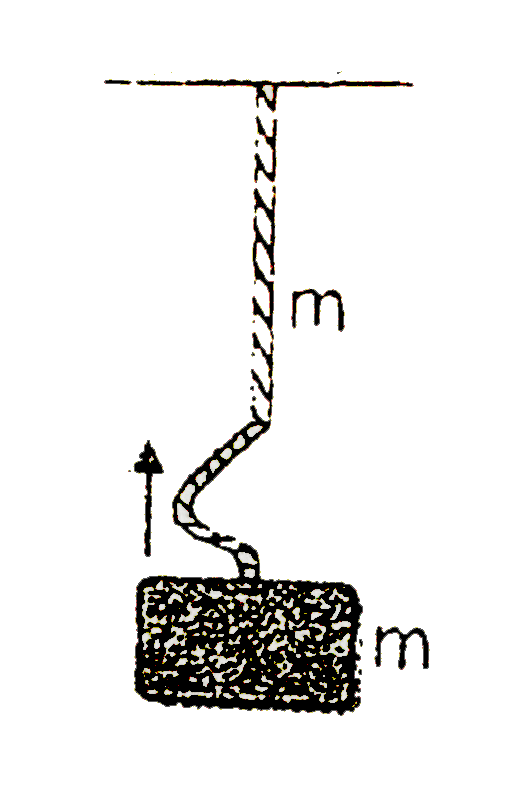A string is hanging from a rigid support. A transverse
pulse is excited at its free end. The speed at which the
pulse travels a distance x is proportional to
(a)x2
(b)x
(c)√x
(d)1x
To solve the problem, we need to determine how the speed of a transverse pulse traveling a distance x along a hanging string is related to that distance.
1. Understanding the Setup:
- We have a string that is hanging from a rigid support, with one end free.
- A transverse pulse is initiated at the free end of the string.
2. Identifying Forces:
- The weight of the string creates tension in the string. The tension T in the string at a distance x from the free end is due to the weight of the string below that point.
- The weight of the string segment below point x can be expressed as:
T=μ⋅g⋅x
where:
- μ is the mass per unit length of the string,
- g is the acceleration due to gravity,
- x is the length of the string below the point where we are measuring the tension.
3. Speed of the Pulse:
- The speed v of a transverse wave on a string is given by the formula:
v=√Tμ
- Substituting the expression for tension T into the speed formula:
v=√μ⋅g⋅xμ
4. Simplifying the Expression:
- The μ in the numerator and denominator cancels out:
v=√g⋅x
5. Conclusion:
- The speed v is proportional to the square root of the distance x:
v∝√x
Final Answer:
The speed at which the pulse travels a distance x is proportional to √x.
- We have a string that is hanging from a rigid support, with one end free.
- A transverse pulse is initiated at the free end of the string.
- The weight of the string creates tension in the string. The tension T in the string at a distance x from the free end is due to the weight of the string below that point.
- The weight of the string segment below point x can be expressed as:
T=μ⋅g⋅x
where:
- μ is the mass per unit length of the string,
- g is the acceleration due to gravity,
- x is the length of the string below the point where we are measuring the tension.
- The speed v of a transverse wave on a string is given by the formula:
v=√Tμ
- Substituting the expression for tension T into the speed formula:
v=√μ⋅g⋅xμ
- The μ in the numerator and denominator cancels out:
v=√g⋅x
- The speed v is proportional to the square root of the distance x:
v∝√x
The speed at which the pulse travels a distance x is proportional to √x.
Similar Questions
A string is hanging from a rigid support. A transverse wave pulse is set up at the bottom. The velocity v of thr pulse related to the distance covered by it is given as

View SolutionA wire of length L, is hanging vertically from a rigid support. If a transverse wave pulse is generated at the free end of wire then which of the following statement is wrong
View SolutionA Uniform rope having mass m hags vertically from a rigid support. A transverse wave pulse is produced at the lower end. The speed v of wave pulse varies with height h from the lower end as
View SolutionA uniform rope of length 12 m and mass 4 kg is hung vertically from a rigid support transverse wave pulse is produced at lower end. The speed of the wave pulse al x = 2.5 m from lower and will be kg=10 m/s)
View SolutionA heavy rope is suspended from a rigid support A wave pulse is set up at the lower end, then
View SolutionA heavy rope is suspended from a rigid support A wave pulse is set up at the lower end, then
View SolutionA uniform string of length 20m is suspended from a rigid support. A short wave pulse is introduced at its lowest end. It starts moving up the string. The time taken to reach the support is :
(take g=10ms−2)
View SolutionA thick uniform rope of length L is hanging from a rigid support. A transverse wave of wavelength λ0 is set up in the middle of the rope. The wavelength of the wave as it reaches the top most point is

View SolutionA uniform string of length 10 m is suspended from a rigid support A short wave pulse is introduced at its lowest end it starts moving up the string the time taken to reach the support is (take g=10m/sec2)
View SolutionA uniform rope of elngth l and mass m hangs vertically from a rigid support. A block of mass m is attached to the free end of the rope. A transverse pulse of wavelength λ is produced at the lower end of the rope. The wavelength of the pulse, when it reaches the top of the rope. is aλ. Find a2

View Solution
